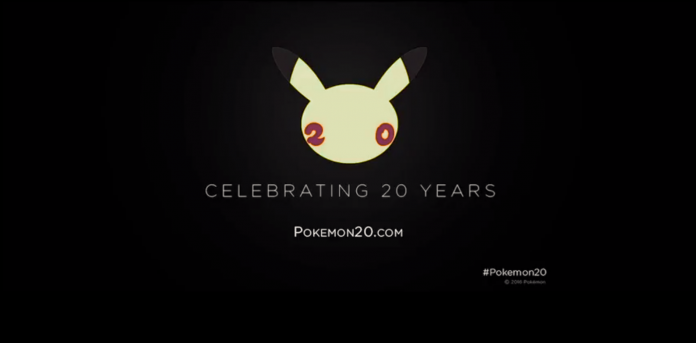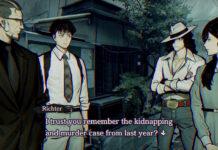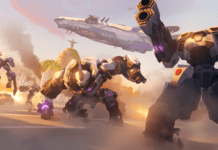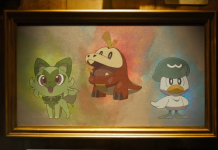Pokemon. For those of us who’ve grown up with video games in our lives, more often than not, Pokemon is the leader of the pack, the game we all immediately think of. It was revolutionary, with fun gameplay, hours of a brand new world to explore, and, best of all, hundreds of creatures for us to catch, play with, and grow closer to. It was a game of bonds, fun and imagination, perfect for childhood wonder.
As people grew up, many considered Pokemon to be just that; for children. Many look back on those childhood memories and, though they may remember them fondly, they think of those moments as beneath them, beyond them. It’s a mindset I’ve seen reflected many times throughout my life, of people thinking all video games are childish, and even other gamers saying Pokemon specifically is only for children. Half the time, it felt like even Pokemon believed that.
 At the time of writing this article, however, Pokemon recently released a new commercial I’ve seen titled simply as “Pokemon: Evolutions” that counteracts this mindset. It’s a beautiful piece, an artistically shot, beautifully composed commercial with a wealth of artistic merit behind it. And so, for my first ever article on this site, I figured I’d take a look at the two things I’m probably best known for; Pokemon and writing, specifically Propaganda, as we review, shot by shot, the Pokemon: Evolutions commercial.
At the time of writing this article, however, Pokemon recently released a new commercial I’ve seen titled simply as “Pokemon: Evolutions” that counteracts this mindset. It’s a beautiful piece, an artistically shot, beautifully composed commercial with a wealth of artistic merit behind it. And so, for my first ever article on this site, I figured I’d take a look at the two things I’m probably best known for; Pokemon and writing, specifically Propaganda, as we review, shot by shot, the Pokemon: Evolutions commercial.
Now, when I say Propaganda, your mind will instinctively go to bad places. China or North Korea censoring the public with lies, Nazis campaigning to recruit new soldiers, any number of instances where governments or evil groups have tried to brainwash citizens. However, in a literary sense, propaganda is not that negative unless you make it that way. Dictionary.com defines propaganda as “information, ideas, or rumors deliberately spread widely to help or harm a person, group, movement, institution, nation, etc.” I define propaganda in a literary sense as simply “the use of persuasive literary devices to sway an opinion and/or call people to action.” In other words, any political statement, any advertisement, any debate, any paper you’ve written for English class, any time you’ve tried to convince your parents to lend you money; all propaganda. It’s simply a tool, and if it’s done well, it can produce some beautiful artwork, as Pokemon has done with this commercial.
If you haven’t watched the commercial, I highly recommend you do now, so you can keep up with me as I post screenshots and describe, in detail, how each solitary second of this commercial is important and describes the story they’re painting:
So, all caught up? Let’s take a look into how each shot tells us something new and important.

The first shot of the entire commercial. You’d think it wouldn’t tell us much, but you’d be wrong. Firstly, and most obviously, the kid in the center of the room. We see his hair, his skin town, the way he dresses, it tells us little bits about him. Overall, it’s not anything I need to list, but I do want you to take notice of his shirt, namely the color. His shirt is red. Keep that in mind throughout the rest of this post.
We learn more about this kid by looking around the room. He lives in a neatly organized, but overall familiar feeling house, like one you might see in a typical family home. To the right, we see some toys, presumably his since he’s the only one in the shot. Funny how the toys are actually somewhat similar in design to certain Pokemon; the panda on its side is like a Snorlax, the… giraffe… dog… dragon… thing in front of it looks a bit like an Ampharos to me, and then, of course, there’s the obligatory dragon or lizard monster facing it. These show us that, surprise, the kid likes to play, but it also shows us why he might be attracted to Pokemon; getting to play a game like his imaginary fights with his toys.
There’s one final, very important aspect of this shot that is a common theme throughout this commercial, and it’s the whole reason I decided to write this article. I guarantee a good number of you didn’t notice this. Look at this shot, the room surrounding the kid, all the objects, and specifically the window. What colors do you see? Yellow, orange, white, beige, different shades of these, but all bright, typically happier colors, almost glowing from the sunlight streaming in through the window. I want you to keep this and the red shirt in mind throughout the rest of this analysis.


These two shots go together, so I’ll be talking about them in tandem (that’ll happen a couple times throughout this). In the first shot, it simply shows us a classic GameBoy Color, the purple one, the one we all saw as kids (I had a lime green one, but I only ever saw the purple one advertised everywhere), and a copy of Pokemon Red (remember the shirt?) and Charizard, that iconic dragon-like non-Dragon type that might appeal to a kid like this one, who clearly plays with dragon toys, as shown in the last shot. I find it really cool that a shot like the first one here, one that just shows off one console and a game with a white background, can connect to the rest of the theming really completely.
I included the second shot because him snapping the cartridge into the console is an interesting image that I still can’t quite figure out, if I’m honest. If you watch the commercial, you’ll notice he kind of misses the entrance at first, but quickly fixes it. I think this shows he’s had the GameBoy Color for a little while, but hasn’t owned this Pokemon game before, and is excited and new at the whole experience, but that part might just be me reading too much into this. I’m curious if any of you see something different in his almost clumsy insertion of the cart.


I mentioned my theory about the kid being new to Pokemon for the last shot because, if that’s true, this next shot shows a clear passage of time. It shows a binder full of Pokemon trading cards with hand drawn pictures on it. In the first screenshot shown above, there are two important facts about the Pokemon drawn on the cover; they’re all generation one, and they all have big, red aspects to their design, the only other visible color being blue (white and black are shades and brown can be considered a shade of red). Also notice that they are, again, hand drawn, by the child we saw in the first scene, as is implied by him owning the binder (shown by him handling it and it being closer to him (kids are territorial; if it wasn’t his, it wouldn’t be by him, and no one else could touch it)). All of these are important, so, again, keep them in mind; they come back later.
The second screenshot above tells us a LOT of information. The kid is once again wearing a red shirt, though a different one from what we saw him wearing first. We also now know he has a sister, who obviously shares his love of Pokemon, since she also has her own Pokemon cards. Notice again how each Pokemon is generation one, just like the ones on the binder, and notice the magazine under the sister’s arm. Nintendo Power. All this tells us something important; this part of the commercial takes place when generation one first came out, when Pokemon was first established as a franchise. This means the kid who’s the main star of this commercial is likely around the same age as someone like me, born in the late 1990s and reaching, or already well into adulthood.
Finally, notice the color schemes again. The reds return again, from the kid’s shirt to his sister’s pink shirt to the chair behind her to the yellow floor. It’s all bright and cheerful again, the only differences being the Pokemon cards and the stool next to the kid (and the drinks, but besides the complementary green coloring, they don’t really tell us too much). Notice how all of the kid’s cards are blue and Water type (also Cloyster is there and that makes me happy). This shows even his binder is neatly organized, like the living room from the first scene, and that he’s evolved to use as many Pokemon as possible. If it was his first time playing the game before, much time has passed now, and he is a much bigger fan of the series than before.

Now notice the blue here. It’s darker, used to signify that night is here, all the blue shrouded in shadow except for the blue moonlight coming in through his curtains. In the last scene, you could notice the blue beginning to become more apparent in the kid’s life, even in the things he loved, like the Pokemon games. Now it’s literally surrounding him, only his blanket covering and lamp on his dresser providing the normal red light as the blue engulfs his surroundings. To me, this is the second most striking shot in the entire commercial. It, at least to me, symbolically shows the kid fighting off the blue as it surrounds him, using his light to keep it at bay. This theming continues and gets even more poignant as the commercial goes on.


What is he doing under that lit blanket, you wonder? Why, playing Pokemon, of course! These shots are important, but they tell us much less than the previous ones. The first screenshot shown above is simply the first time we see the kid’s face. The second screenshot posted above is another returning image of the color red, showing that the kid prefers red so much that his started was Charmander. It also establishes the overarching theme of Evolution which, by the title of the commercial, is obviously important. Keep in mind that this evolution screen is the only part of the actual video games we’ve seen so far. Also, each shot is yet again bathed in a yellow, happy light.


Next, the all important eye transition. Rather than talking about what’s shown in each screenshot separately, I want you to compare the two. The difference should be apparent. In the first shot, everything’s tinted red, a happy color. In the second shot, everything’s tinted blue, which is, of course, a sadder color (we literally describe sad things as “blue”). It’s also much colder.
Also, I haven’t talked about the other artistic aspects of this commercial yet, since there hasn’t really been any. No dialogue to express writing, no real artwork to critique, and the music has just been singular notes, mystical, and edging each transition. Until now, that is. Once his eyes open in the second shot above, the final “mystical” note is a much sadder one than the note that comes before it, and, after that last note, tinnier, more somber piano music starts playing behind every scene, making the cold, sad blue tint even more heartfelt. As a huge fan of sad music, I highly appreciate this; I can feel the emotion behind every note played from here on out.

Once again, bathed in blue light. This lighting change was probably much more obvious to a lot of you. This is because blue light is not very natural, only really seen at night, when we sleep, so we hardly ever notice it, whereas yellow and red light is what we always see, so we don’t register it as a specific color in our minds. The reason I chose this specific screenshot to talk about is his eyes. Now, this is completely speculation, but I see him looking to the left, but going to the right. To me, this shows he’s still curious about the world and wants to go where he can’t, but… well, he can’t. This could very well be me looking way too deeply into someone just looking to the left, but this commercial so far has had a wealth of information in every shot, so it’s not a stretch to believe there’s meaning behind where he’s looking.

We’re told three things in this shot. One: Even with windows showing the outside world, no red or yellow light is getting in. Everything’s still tinted blue, cold and sad, unnatural. Two: He’s alone. In the first few shots, he had his toys or his sister or his GameBoy with him, he had something to call his own, something he could relate to, while here, he could work in this office with millions of other people and we could never tell. Three: Unlike in the bedroom scene, he’s blue, just like the rest of the world, no longer fighting it off.

Again, blue and red are the dominant colors, but blue is once again beating out red. This image actually took me a while to figure out, but the punch card machine is actually here to parallel the GameBoy. Remember how he slid the cartridge in somewhat sloppily, showing he was a bit new at that? Here, he slides the punch card in almost the same way, only without a mistake, as if he’s done this thousands of times. He’s replaced cart for card.


More parallels to earlier shots (which is why I asked you to remember so many themes). The wallet parallels his Pokemon trading card binder, except the wallet isn’t personalized. No drawings like before, not even a picture of a pet, wife or child. A blank, unfamiliar wallet, filled with not trading cards, but credit cards, shown in the second shot shown above, where he places one down like he did his trading card before, only instead of talking to his sister, all that’s to his left is a keyboard. Now, I’m a messy person, so the office space in the second shot looks organized to me, but it also seems to be messier than how we saw the kid before, perhaps showing he cares less about his space now that he’s grown into this cold blue world.

The dominant color once again switches back to red. However, it doesn’t touch much of his body; instead, the background is more illuminated than he is. The most light we can see touching him is from his tablet, which is reflecting blue light. He’s also no longer hiding, like he was back when he was a kid, the blue light now able to touch him. He’s also reading, objectively worse than playing video games (this is scientifically proven, don’t ask me to provide sources).
The final scene of the commercial provides so much theming and information in quick bursts that, in order to let this flow better, I’ll post almost all the screenshots I want to talk about from the final scene before talking about them.




He walks down a dark alley, shrouded in a red darkness, until the Sun and Moon posters become visible, light shining on his face. He once again looks to his left, seeing the advertisement for the new games, the loneliness of his adult life emphasized by “Make Friends!” being the only visible phrase on the window pane. Suddenly, Charizard, the mascot of his childhood game, appears on screen, and, with his childhood memories flooding back, he smiles, leading the music to chime out in the whimsical tones of his childhood to one of Pokemon’s most iconic theme songs over the message of the commercial, paralleling the only footage of the games we saw in this commercial.
You evolved. So did we.
For Pokemon’s 20th anniversary, I think it’s safe to say we’ll be getting the most artistically sound, mature, passionately made experiences we’ve ever gotten from Nintendo. Pokemon: Evolutions gives us one of the most resounding examples of this belief yet.
That’s how much information can be conveyed in just a minute and ten seconds. Pokemon did an amazing job created a relatable, heartwarming, loving commercial, and it deserves to be commended. Before I end off this article, however, I have one last screenshot to show you. My favorite from the commercial, and by far the most striking, in my opinion. Along with one final observation.

The light shining on his face, for his first smile in this commercial, is blue.




